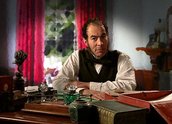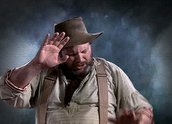


Riot or Revolution 2005
Producer Don Parham comments on 'Riot or Revolution’
Where the idea for the film came from
My wife and I were returning to Melbourne via Ballarat after a relaxing weekend at Daylesford. We had a couple of hours up our sleeve and ended up at the Eureka Centre, built on the site of the original stockade. It is an impressive building with a giant rebel flag out front that is visible for miles around. As you enter you are confronted by George Browning’s extraordinary painting of the battle and then, as you weave your way through the museum, you are taken on a thrilling multimedia journey that brings to life the Eureka legend.
As I wandered through the Eureka Centre, I got more and more excited. I had entered as a tourist, but came out as a filmmaker. Three things had struck me about the Eureka story – it was a ripper yarn, it had a great cast of characters and the politics of it seemed fascinating. One small quote, tucked away in a corner of the museum, had caught my eye. It was the words of Sir Charles Hotham, the Governor of Victoria at the time. He said,
Tell the diggers from me, and tell them carefully, that this Commission
will inquire into everything and everybody, high and low, rich and poor, and you have only to come forward and state your grievances,
and in what relates to me, they shall be redressed.
I became curious to find out more about the context of this quote and the man who said it. I certainly couldn’t remember any version of the Eureka story that had put flesh on the character of Hotham. He was always just this vague bad guy in the background, the autocratic tyrant who caused the Eureka catastrophe. When I read that quote, however, I thought ‘these don’t sound like the words of a tyrant’. It opened up a whole line of inquiry in my mind, namely, that there must have been an opportunity for negotiation between the government and the rebels, perhaps even an opportunity for Eureka to have been avoided. The film was born.
Stylistic problems and solutions
There are very few photographs of Victoria at the time of Eureka. I realised that people drew and wrote about their world. So this became the window I chose to look through, that is, I decided the film would be largely constructed around the actual words and pictures that people at the time created in order to record their lives and tell the story of Eureka.
Riot or Revolution tells the story of the Eureka Stockade largely through the eyes of three main characters – the Governor, Sir Charles Hotham; Raffaello Carboni, an Italian gold digger who became one of the Eureka leaders; and Douglas Huyghue, a civil servant in the goldfield’s administration at Ballarat. Each of these men left us personal writings that record their observations and feelings about the events at Eureka. Their eyewitness accounts provided rich primary source material which I used as the text for monologues spoken direct to camera by a wonderful ensemble cast.
As the caption at the start of the film says – ’’the lines spoken by actors in this film are the documented words of the historical characters’. I wanted this to be history grounded in original texts, something more than a film which only claims to be ’based upon’ real events. I also loved the language our protagonists used in their writings. It was grand and florid prose and revealed that they saw themselves as actors in a great drama. I reinforced this idea by setting the actors against painted backdrops. It is like they are on a stage and, accordingly, their performances are deliberately large and theatrical.
Given that Eureka largely predates photography, I was faced with a real dilemma – what pictures would be on the screen? I discovered an incredibly rich historical record in pictures of another kind. Scouring the National Library, various state libraries, the Ballarat galleries and museums, I unearthed great treasures of colonial art from the period. It seemed the perfect marriage – I’d found the ‘word’ gems in the writings of our main characters, now I had found the ‘picture’ gems.
The colonial artist S T Gill quickly became a favourite and I ended up using many of his paintings. I feel his works are like photojournalism at its best, wonderfully observed ‘decisive moments’ full of satire and social comment, in the style of Henri Cartier-Bresson. I also used some magnificent oil paintings such as the iconic panorama of the Ballarat Goldfields in the summer of 1853-54 by Eugene von Guerard. How wonderful to have such an image that captures the very landscape where Eureka occurred. Indeed, he painted the scene from the point of view of the Government Camp (present day Lydiard Street) looking down on the diggings and with the distinctive shape of Mount Warrenheip in the distance. It is exactly the position from which Douglas Huyghue describes the scene on the morning of the battle.
There’s another, more personal, reason why I chose to make such extensive use of these ’primary source’ pictures – it was because of the fond memories I have of reading bedtime stories to my three daughters when they were young. It was my custom to read a page and then turn the book around so they could see the pictures. I can remember their anticipation at seeing the next picture. To see the way they entered that world through those pictures was something I’ll never forget. I guess I was hoping that, through the artworks used in Riot or Revolution, the audience might have a similar experience. By looking at the pictures through which people back then captured their world, perhaps the reality of Eureka and its time would become more vivid.
Don Parham Producer, Director, Writer
Disclaimer: Any opinions, advice, statements, views or other information expressed by the creator/s (including in relation to any third-party content they submit to the site) are solely provided by, and the legal responsibility of, the creator/s and not of the National Film and Sound Archive. While the NFSA will monitor the contents of submissions from creator/s, we do not certify, endorse or verify the contents of any communication published on this page. The National Film and Sound Archive reserves the right to remove any comments from this page at its discretion; this reservation creates no affirmative duty in the NFSA, and failure to exercise this power shall not subject the NFSA to any liability of any sort. If you have any concerns about this content please contact editorial@aso.gov.au.
- Overview
- Curator’s notes
- Creator’s comments
- Video 3 clips

- Principal credits
- Find a copy
- Make a comment
- Add your review


